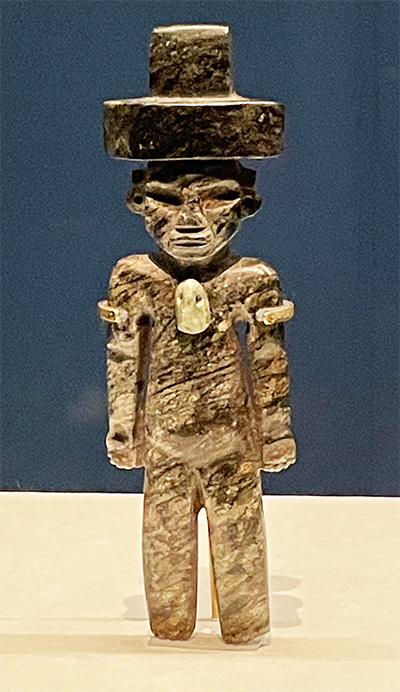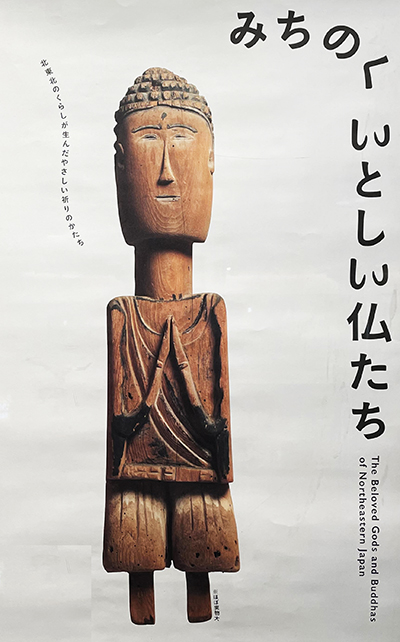

古代のメキシコ文明と、人類の全大陸進出・グレートジャーニーでは「ほんの」3万年前に別れ別れになった日本文化との対比チャレンジシリーズであります。きのうは宗教都市テオティワカンの太陽のピラミッドと時代的にも相応すると思える仁徳天皇陵古墳を対比してみた。世界中でこうした土木工事によって人工造形を作ってそこに権力の象徴性を持たせるのは人類社会一般に行われる営為。
で、テオティワカンではこのピラミッドの中心部分から上の2体の像が出土している。一方日本の仁徳天皇陵は天皇家に直接関わるとされることから調査活動は行われていない。ただ、なにかは供えられたに違いない。高松塚古墳の例のようにみごとな壁画など死者を悼み、鎮魂させるお供えは人類普遍でしょう。
こちらのテオティワカン像2体の説明として、実在の高貴な人物(下)と、生け贄に供された人物(上)を表しているとされる。おお、ついに「生け贄」風習の降臨であります(笑)。なぜか、古代メキシコでは神に対して生け贄を捧げるという宗教文化が猛烈に盛り上がっている。
自然神に対しての信仰心の最高の表現として、人命をささげるという精神性は人類普遍であったのだとは思える。日本でも貴人が死んだら後を追って命を捧げるという精神文化は存在した。武士の「追い腹」というような風習にはそういう文化を見て取ることが出来る。
しかし日本の古墳期では古墳に対して人間の代わりに大量の埴輪が並べられた。中国文明の場合の兵馬俑などもそういった風習の名残だろうか。貴人の死とは言え、人命を捧げるというのはあまりにも酷いという社会全体の判断が働いていったのだろうと思える。ところが、古代メキシコでは延々とこの風習が継続する。
スペイン人たちがこの古代メキシコの社会と遭遇したときにその社会を破壊したのには、この風習を禍々しいものと断定する精神性的否定の心があったように思える。「狂ったように生け贄を捧げている」というように近代の精神性からは見えていたのだろう。西洋人は日本社会との遭遇では「利用する」ことを考えたけれど、古代メキシコとの遭遇では全否定に向かってしまった。

そんな太陽のピラミッド像に対置したくなったのは、東北の古民俗として最近話題になっている仏像。写真は12月から来年2月にかけて東京駅の美術館「東京ステーションギャラリー」で開催されるポスターの抜粋画像。NHKのテレビ番組などでもユーモラスに取り上げられていて、わたしも見ておりました。
日本社会は世界宗教である仏教を受容していったけれど、その最終的到達地点であるみちのく・東北では「民俗」に沈殿していって、いかにも人間味にあふれた仏像群に開花していっている。
ただ、メキシコの「生け贄」像の表情から伝わってくるものにもある種の肉声が感じられる。わたしたち日本人には西洋人とはまた違った精神性の痕跡があるのではないだろうか。
English version⬇
Statues of Teotihuacan Pyramid and Northeast Buddhist Statues Ancient Mexico-4
Two statues found in the Pyramid of the Sun. The statues of a nobleman and a “sacrifice”. The expression on the sacrificer’s face suggests a Northeast Michinoku folk Buddhist image. …
This is a series of challenges to contrast the ancient Mexican civilization with the Japanese culture, which parted ways “only” 30,000 years ago in the Great Journey and expansion of mankind throughout the continent. Yesterday, I compared the Pyramid of the Sun in the religious city of Teotihuacan with the Nintoku Emperor’s Tumulus, which seems to be appropriate for the time period. It is a common practice in human society to create man-made structures through civil engineering works around the world and give them symbolic power.
In Teotihuacan, the two statues above were excavated from the center of the pyramid. On the other hand, the Nintoku Imperial Mausoleum in Japan has not been investigated because it is considered to be directly related to the emperor’s family. However, something must have been offered to the emperor. As in the case of the Takamatsuzuka burial mound, offerings to mourn and repose the dead, such as beautiful wall paintings, must be universal among human beings.
The two Teotihuacan statues here are said to represent a real nobleman (bottom) and a sacrificed person (top). Oh, it is finally the descent of the “sacrifice” custom (laugh). For some reason, the religious culture of offering sacrifices to the gods has been intensely popular in ancient Mexico.
It seems that the spirituality of offering human life as the highest expression of faith in a natural god was universal among human beings. In Japan, too, there existed a spiritual culture of offering one’s life after the death of a nobleman. This culture can be seen in the custom of the samurai called “Oibukiri.
However, in the Kofun period in Japan, a large number of haniwa (clay figurines) were laid out in place of human figures in kofun tombs. In the case of Chinese civilization, the terracotta army may be a remnant of such custom. It seems to me that the entire society judged that it was too terrible to sacrifice human life, even if it was the death of a nobleman. In ancient Mexico, however, this custom continued for a long time.
It seems that the Spaniards destroyed the ancient Mexican society when they encountered it, because of their spiritual denial that this custom was a disaster. It would have appeared to the modern mentality as “crazy sacrifices.” Westerners thought of “using” Japanese society when they encountered it, but when they encountered ancient Mexico, they went into total denial.
I wanted to juxtapose the Pyramid of the Sun statue with a Buddha statue that has recently become a topic of conversation as an ancient folk custom in Tohoku. The photo is an excerpt from a poster for an exhibition at the Tokyo Station Gallery, a museum in Tokyo Station from December through February of next year, which I have seen featured humorously on NHK TV programs.
Japanese society has accepted Buddhism as a world religion, but in Michinoku and Tohoku, the final destination of Buddhism, it has been precipitated into “folk customs” and has blossomed into a group of Buddhist statues full of humanity.
However, the expression on the face of the Mexican “sacrificial” statues also conveys a certain kind of human voice. I believe that we Japanese have traces of a spirituality different from that of Westerners.
Posted on 9月 20th, 2023 by 三木 奎吾
Filed under: 歴史探訪







コメントを投稿
「※誹謗中傷や、悪意のある書き込み、営利目的などのコメントを防ぐために、投稿された全てのコメントは一時的に保留されますのでご了承ください。」
You must be logged in to post a comment.